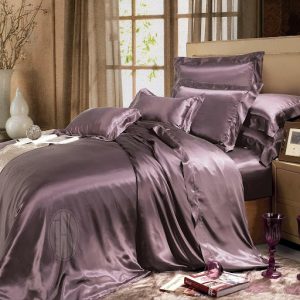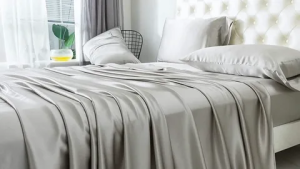Mulberry silk is a luxurious fabric known for its lustrous sheen and smooth texture. It has been the symbol of elegance and wealth since ancient times. Of the various types of silk available, mulberry silk sheets seem to be the most popular and highly prized. The other kinds of silk, like Eri, Tussar, and Muga, also have some distinct features and benefits. In this blog, we highlight these, so you can understand what really makes every type unique.
1. Mulberry Silk
Mulberry silk is always referred to as being the top of top-grade silk. And that’s practically true since it is the number one silk that’s produced and used around the world. And here’s why Mulberry silk is such a big deal:
- Origin: Mulberry silk is produced by the Bombyx mori silkworm, fed on the Mulberry tree’s leaves. This diet is what makes the quality of the silk exceptionally high.
- Texture and Radiance: Being very smooth naturally, and with a very fine texture that comes from the high filament content in the cocoon, it is very radiant, having brilliant gloss. Its luster is what exudes a pleasing sheen that it is known for in the world of fashion.
- Strength and durability: One of the worth-mentioning characteristics of mulberry silk is its strength. With the Bombyx mori silkworm producing long, unbroken fibers, mulberry silk is, therefore, very strong—much stronger than any other kind of silk.
- Hypoallergenic Properties: Mulberry silk has natural hypoallergenic properties. As the silk fabric is tightly woven, it becomes naturally resistance to dust mites and other allergy-causing organisms, therefore good for people with an over-sensitive skin condition or to those who have an existing allergy.
- Color Consistency: Mulberry silk is usually white or off-white, thus easy to dye, and the color is consistent, thus it can be used for everything, from clothing to home interior purposes, without color inconsistency.
2. Eri Silk
A rapidly growing alternative to Mulberry silk is the Eri silk, also known as “peace silk” or “Ahimsa silk.” Below is how Eri silk is unlike the Mulberry silk.
- Source: The Eri silk is produced by the Samia ricini silkworm, which feeds on castor leaves. In contrast to Mulberry silk, whereby the rearing silkworms are normally killed so that you can remove silk from its cocoon, Eri silk is collected without killing the moths; for that reason, it is typically referred to as the “peace silk.”
- Texture: Eri silk has a slightly rougher texture than that of Mulberry silk. It is not as smooth and lustrous, but it has its own natural appearance that adds to a rustic appeal in its look.
- Warmth: The other name for Eri silk is Ahmedabad, known best for its warmth and worn majorly in shawls and scarves. It is even more absorbent than Mulberry silk, making it better suited for cooler weather.
- Ethical Production: There is involving a lesser killing in the production of Eri silk, thereby the “peaceful cocoon.” Appeal to a rising class of consumers who are becoming ecologically and ethically conscious about their fabric choices.
3. Tussar Silk

Tussar silk, called “wild silk,” is of “another variety” for several reasons other than the Mulberry silk:
- Origin: Tussar silk is the copper-coloured, natural, and gold-hued silk produced by silkworms that feed on wild forest trees like Sal and Arjun, among several others. Since the cultivation of these silkworms isn’t done, it is called “wild silk.”
- Texture and Appearance: Tussar silk is coarser in texture compared with Mulberry silk, not possessing the same degree of uniformity as Mulberry silk. It is rich golden in color and is slubby in texturing; this imperfection only enhances tussar silk to be more aesthetically pleasing. It possesses a rich, golden color and perfect texturing that adds to its aesthetic value.
- Durability: Tussar silk is considered strong but is not as durable as Mulberry silk. The shorter fibers of Tussar silk predispose it to wear and tear.
- Natural color: Tussar silk has a native golden hue, which is one of the main distinguishing features of tussar silk. Being naturally of such color, it is highly recommended to enhance the attire of traditional Indian sarees or other ethnic wear.
- Sustainability: Tussar silk is considered more sustainable than Mulberry silk. This is because it is harvested from wild silkworms, where intensive farming is not required.
4. Muga Silk
Mainly produced in Assam, in India, Muga silks are very rare and costly silks characterized by their natural golden color and very high durability.
- Source: A Muga silk product is created from the cocoon of Antheraea assamensis silkworms, which in turn feed mainly on Som and Sualu leaves. Since these silkworms are found only in Assam, the Muga silk is both singular and regional.
- Color: Its natural golden color is remarkable and tends to obtain a better luster after each subsequent wash. Unlike other kinds of silk, the sheen in Muga happens to increase upon successive washes of the garment made by it. Hence it is most desired to make traditional garments, especially sarees.
- Durability: Muga silk is extremely tough in tensile strength, making it very long-lasting like Mulberry silk. Muga silk garments are handed down through generations and turn into heirlooms.
- Rarity: The volume of Muga silk produced is very low in comparison to other varieties, and the finish and rarity make it as costly as any silk available in the world. The labor-accumulative process of the harvesting and weaving of Muga silk makes it highly expensive and exclusive.
- Cultural Importance: In Assam, Muga silk is looked on as not merely a fabric but more of a cultural earmark. These are usually worn at important ceremonies and are considered a prestige and a heritage.
The Bottom Line

Though Mulberry silk still tops the list among all the silks owing to its unsurpassed smoothness, shine, and strength, other types of silks such as Eri, Tussar, or Muga offer their own special benefits and features for a diversified range of tastes and needs. Eri silk is especially favoured by conscience customers, while tussar silk actually highlights the natural colour and texture, and Muga silk is highly prized for its rarity and cultural status. These differences help define wise selections of silk products for fashion, home decor, or even special occasions.
If you are looking for a trustworthy supplier of pure mulberry silk bed sheets, look no further than Mayfairsilk. They have the most premium collection of mulberry silk bedsheets made up of lustrous Grade 6A Mulberry silk.

